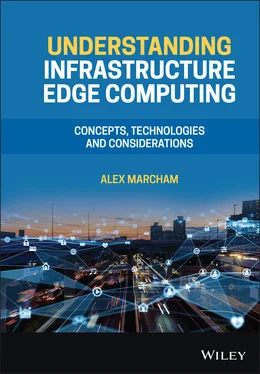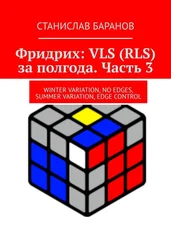Alex Marcham - Understanding Infrastructure Edge Computing
Здесь есть возможность читать онлайн «Alex Marcham - Understanding Infrastructure Edge Computing» — ознакомительный отрывок электронной книги совершенно бесплатно, а после прочтения отрывка купить полную версию. В некоторых случаях можно слушать аудио, скачать через торрент в формате fb2 и присутствует краткое содержание. Жанр: unrecognised, на английском языке. Описание произведения, (предисловие) а так же отзывы посетителей доступны на портале библиотеки ЛибКат.
- Название:Understanding Infrastructure Edge Computing
- Автор:
- Жанр:
- Год:неизвестен
- ISBN:нет данных
- Рейтинг книги:4 / 5. Голосов: 1
-
Избранное:Добавить в избранное
- Отзывы:
-
Ваша оценка:
- 80
- 1
- 2
- 3
- 4
- 5
Understanding Infrastructure Edge Computing: краткое содержание, описание и аннотация
Предлагаем к чтению аннотацию, описание, краткое содержание или предисловие (зависит от того, что написал сам автор книги «Understanding Infrastructure Edge Computing»). Если вы не нашли необходимую информацию о книге — напишите в комментариях, мы постараемся отыскать её.
Understanding Infrastructure Edge Computing
infrastructure edge computing
Understanding Infrastructure Edge Computing
Understanding Infrastructure Edge Computing — читать онлайн ознакомительный отрывок
Ниже представлен текст книги, разбитый по страницам. Система сохранения места последней прочитанной страницы, позволяет с удобством читать онлайн бесплатно книгу «Understanding Infrastructure Edge Computing», без необходимости каждый раз заново искать на чём Вы остановились. Поставьте закладку, и сможете в любой момент перейти на страницу, на которой закончили чтение.
Интервал:
Закладка:

Figure 2.5 Application with access to infrastructure edge computing resources.
In many cases, the ideal set of resources does not exist in only one of these three locations. To make the best use of this gradient of resources from device to national data centre, an application and its operator should seek to optimise which functions are performed using which set of resources and take into account the individual characteristics of each of these sets. This is a complex issue which will be explored further in this book; do not worry too much about the minutiae of this right now.
As can be seen from this example, just as the use of the RNDC expanded the capabilities of applications which previously could rely on the resources available to them only on a user’s device, the IEDC adds an additional layer of resources which augments the capabilities of both the device and the RNDC. This gradient of resources which spans from the device in a user’s hands to an IEDC all the way to a national data centre which may be thousands of miles away, is the foundation of the next‐generation internet, enabling new valuable classes of applications and use cases to be practical.
2.7 Summary
This chapter formed the basis of an introduction to edge computing, describing the key terminology and many of the core concepts which are driving the design, deployment, and operation specifically of infrastructure edge computing but also with coverage of device edge computing. The terminology and concepts described in this chapter will be used frequently throughout the rest of this book, so it may be useful to refer back to the key points of this chapter at a later date to refresh your memory.
In the next chapter, we will explore the foundations of network technology to give full context to the impact of infrastructure edge computing on these concepts and to then establish a clear baseline on which to build our understanding of how tomorrow’s networks will differ from those we see today.
References
1 1 The Linux Foundation. Open glossary of edge computing [Internet]. 2019 [cited 2020 Sep 30]. Available from: https://www.lfedge.org/openglossary
2 2 The Linux Foundation. State of the edge [Internet]. 2019 [cited 2020 Sep 30]. Available from: https://www.stateoftheedge.com
3 3 The Linux Foundation. LF Edge [Internet]. 2020 [cited 2020 Sep 30]. Available from: https://www.lfedge.org
4 4 DARPA (Defense Advanced Research Projects Agency). ARPANET [Internet]. 2020 [cited 2020 Sep 30]. Available from: https://www.darpa.mil/about‐us/timeline/arpanet
5 5 Akamai Technologies. Company history [Internet]. 2020 [cited 2020 Sep 30]. Available from: https://www.akamai.com/us/en/about/company‐history.jsp
3 Introduction to Network Technology
3.1 Overview
To gain a fully contextualised understanding of the impact of infrastructure edge computing on our internet infrastructure, we must have a common understanding of the design and operation of the networks which are in use today from the grand scope of their overall architectural principles to the underlying protocols which make them work. This chapter will explore modern network design and operation, with the aim of establishing the reader with an understanding of the most relevant parts of the topic, which will be used throughout the rest of this book as further concepts are introduced.
3.2 Structure of the Internet
Although the internet may appear to be one single amorphous entity, this is not the case at all. The internet is a network of networks – a complex system of protocols, physical infrastructure, and many layers of agreements between network operators to work together for the mutual benefit of each party involved. A thorough analysis of every aspect of the structure of the internet is outside of the scope of this book, but a progression through the major stages of the parts of internet infrastructure which are most relevant to infrastructure edge computing and its main driving factors is warranted.
Although many of the major stages in the evolution of the internet have been described briefly in the previous chapter, the following sections will describe the implications of these changes for the design of the networks which, joined together, make up the internet as we know it in greater detail.
During this chapter, the term network endpoint, or endpoint, will be introduced. It refers to any entity on the network that is capable of sending and receiving data which is transmitted using the network. It is a generic term that encompasses any scale, capability, or role that an endpoint may have, from the tiniest embedded sensor for internet of things (IoT) to a room‐sized supercomputer, as long as that entity can perform those functions, regardless of the speed at which it does so or its other uses.
3.2.1 1970s
Although telephone or telegram networks, as well as other attempts at computer networks, could be considered precursors to the modern internet, for the purposes of this section we will choose to use the Advanced Research Projects Agency Network (ARPANET) as designed at its inception in 1969 as our starting point. This focuses the discussion in this book on the parts of the internet which are deployed in the United States; however, this pattern has been observed across the internet infrastructure that exists in many other countries worldwide.
The ARPANET was an advanced design and implementation of cutting‐edge network technologies that laid the foundation for the internet of today and tomorrow, despite how quaint it may look to some in the present day. It remains an excellent example of how even though over time the specific technologies used to achieve an aim may change as progress is made in their individual areas, solid design principles can still be used to ensure that any changes are in service of the original intention.
3.2.2 1990s
Throughout the 1990s, internet usage rapidly accelerated across a variety of dimensions. Not only did the number of internet users grow quickly, but so did the amount of data that they each sent and received due to a slew of new use cases and services which were accessible online. This pushed internet infrastructure to evolve across each of those same dimensions; coverage expanded, speeds increased across each part of the internet’s constituent networks, and regionalisation accelerated.
As described in the previous chapter, the key theme that we can see developing between each of these stages in the architectural evolution of the internet is increasing regionalisation. Both network and server or data centre infrastructure have at this stage begun to push out closer to the locations of their end users, through a combination of expanding existing areas of internet service availability and the addition of new areas over time to capture the growing demand for new key online services.
3.2.3 2010s
The 2010s saw the widespread adoption of two significant use cases for internet infrastructure: cloud computing and streaming video services. Both of these have proved instrumental in how we design large‐scale networks in the years since, driving both heavy, highly asymmetric use of downlink network bandwidth during the evenings as people turn to internet‐provided alternatives to cable TV services for entertainment and large uploads of data for both transactional purposes as well as long‐term storage during the day as more business applications shift from on‐premises to cloud services.
Читать дальшеИнтервал:
Закладка:
Похожие книги на «Understanding Infrastructure Edge Computing»
Представляем Вашему вниманию похожие книги на «Understanding Infrastructure Edge Computing» списком для выбора. Мы отобрали схожую по названию и смыслу литературу в надежде предоставить читателям больше вариантов отыскать новые, интересные, ещё непрочитанные произведения.
Обсуждение, отзывы о книге «Understanding Infrastructure Edge Computing» и просто собственные мнения читателей. Оставьте ваши комментарии, напишите, что Вы думаете о произведении, его смысле или главных героях. Укажите что конкретно понравилось, а что нет, и почему Вы так считаете.












